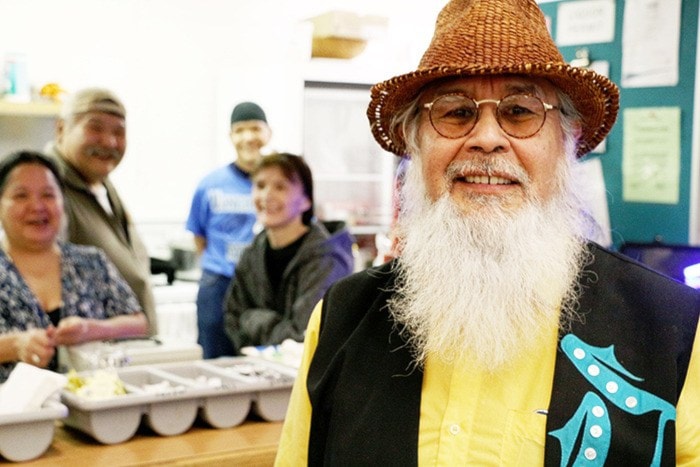A line formed while the bearded man, wearing a hat woven out of cedar and a vest decorated with buttons, whipped the soapberries into a creamy consistency.
Taking a break from his canteen duties at the All Native Basketball Tournament last month, Reverend Peter Nelson introduced himself to me and explained how soapberries can be manipulated into ice cream or used for warding off illness.
At first bite, soapberry ice cream is bitter — an aquired taste that many at the tournament seemed to have, including the reverend.
Saytlaxha — his Nisga’a name meaning “hands up in the sky” — is now retired from his duties at the Port Edward church. But he remains active in the community as a board of directors on the Gitmaxmak’ay Nisga’a Society and volunteering with the Friendship House.
Born and raised in Port Edward, he decided to move 10 years ago to the “big city” of Prince Rupert where he consistently feeds into his roots and culture at the Nisga’a Hall.
“I always encourage others to come, I encourage them to breathe life into it and if you don’t it’s going to fall asleep,” Nelson said.
His roots are also entwined in the cannery industry on the coast. When he was young, he grew up on a cannery in what was known as the Native Village.
“As a child I did not know there was segregation. But as children it didn’t mean anything to us. There were native, white and Japanese at our community. But we all went to school, we all had a lot of fun.”
Nelson came from a family of 12, which he said was small compared to others in the area. At the cannery, the kids would observe their aunties and uncles at work and they would pitch in by chopping wood and carrying water.
In 1969, he started his career at the cannery. He would ice the totes, wash the fish, and steadily worked his way up the ladder.
When he was 15-years-old, he met his haak’ak — his woman, his backbone, Loretta.
They used to be neighbours, they went to school together, and they even stayed at the hospital at the same time, but it took a messy moment at a birthday party to finally break the ice.
Loretta had an empty seat next to her when Nelson walked into the room. She placed her cake down on the chair, hoping he wouldn’t sit there, but he was oblivious to the gesture and sat on the dessert. She laughed and at last they connected.
The couple raised four children and worked in the canneries their whole careers.
“We were married into one industry,” he said.
But cannery work wasn’t his only endeavour. For 25 years he was an independent videographer. What had started as a hobby developed into a fine tuned skill that came high in demand.
Nelson studied small business management to better grasp the numbers of being a freelance videographer — numbers, not money — he pointed out.
From Monday to Friday, he’d work at the cannery and on weekends he went wherever he needed to go to film. The furthest he travelled for work was Japan. He went to show his company’s clients in Japan how fish was processed on the North Coast.
Videography projects also took him Alberta, Vancouver and Alaska. However, the majority of his work was with the All Native Basketball Tournament.
Then one day he decided to put his video camera down for good and become a priest.
Nelson had been taping at weddings, where he met a couple of priests who planted the seed to take up with religion. Once he put his camera down, he spent the next 20 years as a reverend at the Church of Christ the King in Port Edward.
Now in his retirement, Nelson gives his time and energy to the Friendship House and the Nisga’a Society.
The clang of dishes and chatter picked up throughout our conversation, as the civic centre’s auditorium came alive with vendors prepping their tables.
The canteen is part of a fundraiser for the Friendship House. The members contributed seafood, and each day they made another traditional dish for the basketball players and onlookers: cockles chow mein, fish hash, herring eggs in a stir-fry and clam fritters.
Later on in the day, when I returned to sample a couple of those dishes, Nelson was back on soapberry duty.
Now, that the All Native Basketball Tournament is complete, Nelson has turned his attention to dance. He said he was heading up the Nass Valley to drum with the Nisga’a dance troupe, breathing more life into his culture and keeping it alive and well.
